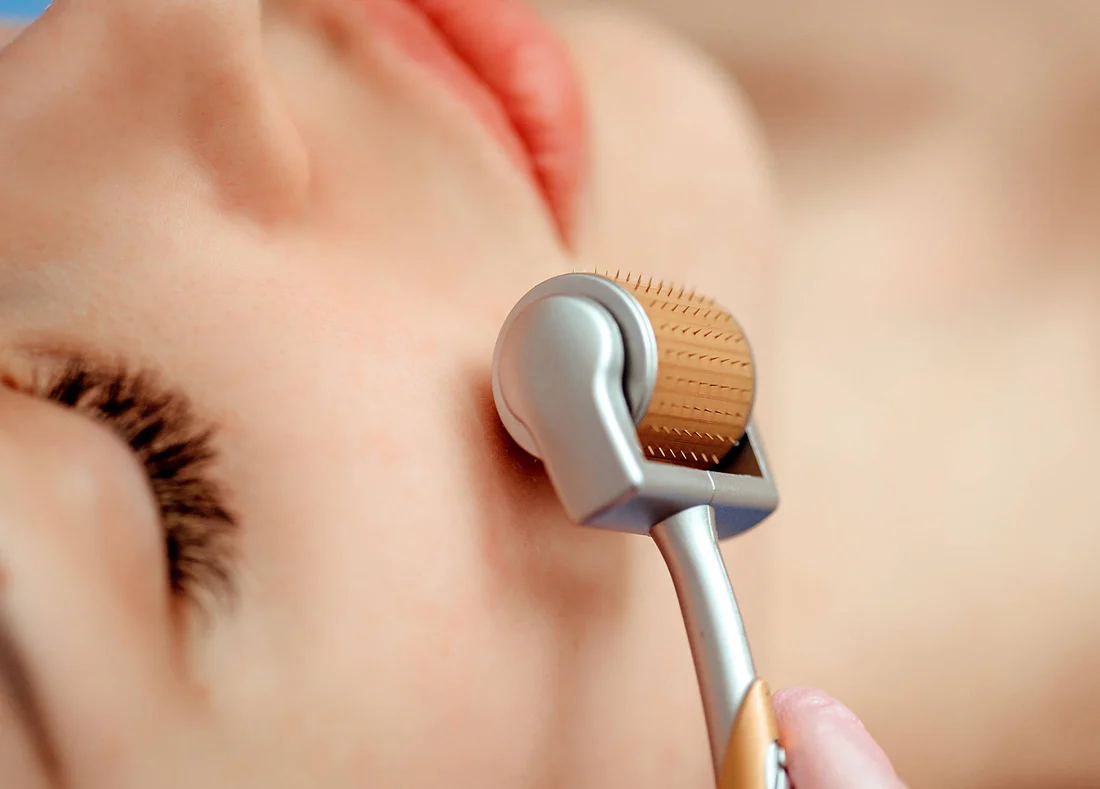The idea of microneedling may seem intimidating, but it’s actually an effective skincare treatment with numerous benefits. Its primary advantage lies in promoting the skin’s natural healing process, which visibly reduces fine lines and wrinkles. Additionally, it addresses issues like uneven texture caused by acne scars or other skin conditions.
If you’re curious about how microneedling works and its benefits, let’s break it down.
How Does Microneedling Work?
Microneedling involves using a small, pen-like device equipped with tiny needles. These needles create micro-tears in the skin, triggering the production of collagen and elastin as the skin believes it’s been injured. This process results in the growth of new skin cells, giving you a brighter, plumper, and more youthful complexion.
Collagen: Found in the deeper layers of the skin, collagen supports skin structure and maintains its youthful appearance. However, as we age, collagen production slows, leading to visible signs like fine lines, wrinkles, and a weakened skin barrier.
Elastin: Known as the skin’s protein, elastin keeps the skin firm and flexible. A decline in elastin makes the skin sag, contributing to an aged appearance.
Microneedling is commonly offered at professional salons and spas and should always be performed in a sterile environment by a trained expert. While at-home devices are available, they require thorough research and careful use to avoid skin damage. If your budget allows, seeking professional treatment is the safer option.
Post-Microneedling Care
Aftercare is crucial for optimal results from microneedling. Certain ingredients should be avoided entirely, while others can be reintroduced at the right time. Today, we’ll explore whether it’s safe to use vitamin C after microneedling and the best practices for post-treatment care.
Is Vitamin C Safe After Microneedling?
Yes and no. You should only use vitamin C immediately after microneedling if advised by your dermatologist. Vitamin C’s antioxidant properties can aid in healing and maintaining skin health. However, it’s generally best to avoid potent actives like vitamin C, glycolic acid, salicylic acid, and retinol immediately after microneedling.
Microneedling creates tiny tears in the skin, leaving it more vulnerable to irritation and adverse reactions. Always consult the professional performing your treatment to determine if vitamin C is suitable for your post-care routine.
What Serum Should You Use After Microneedling?
Hyaluronic acid serums are the top choice after microneedling. With its moisture-binding properties and ability to hydrate multiple skin layers, hyaluronic acid promotes healing and soothes the skin. Microneedling also enhances the serum’s absorption, maximizing its hydrating effects.
If your skin feels tight after the treatment, applying a generous layer of hyaluronic acid serum will provide immediate comfort and leave your skin glowing.
Should You Use Moisturizer After Microneedling?
Definitely! Moisturizers help restore the skin’s lipid barrier and lock in hydration. Look for formulas enriched with ingredients like hyaluronic acid, vitamin E, and other nourishing actives. Avoid moisturizers containing fragrances or harsh additives that may irritate the skin.
What to Avoid After Microneedling
Exfoliating Ingredients: Retinol, AHAs (like glycolic acid), and BHAs (like salicylic acid) should be avoided until your skin heals. These can cause dryness, redness, and irritation.
Direct Sun Exposure: Apply SPF regularly for at least two weeks post-treatment to protect your skin from harmful UV rays and environmental damage.
Touching Your Face: Minimize contact with your hands to prevent bacterial infections.
Makeup: Refrain from using makeup and makeup brushes for the first 24 hours.
Swimming, Saunas, and Exercise: Avoid activities that cause excessive sweating for at least 72 hours.
Summary
After microneedling, focus on hydration and protection by using products like hyaluronic acid and moisturizers. Avoid active ingredients that can irritate your skin during the healing process. Following these guidelines will ensure your skin recovers effectively, leaving it radiant and healthy.
For more tips and answers to your questions, feel free to connect with us on Instagram!
DQH Knowledge drop: In your 20s, your skin cell turnover decreases. (Cell turnover is a key component in keeping your skin youthful.) You know what else slows down? Your collagen production. Starting in your 20s, collagen decreases by about 1 percent per year. Should you want to prevent fine lines and wrinkles, start by eliminating behaviors that contribute to premature aging. “If it’s bad for you, it’s bad for your skin,” says dermatologist Michel Somenek.
“Cigarette smoking reduces blood flow to the skin and causes premature wrinkling and a dull skin texture. Making the repeated pursed motion to inhale can also cause smoker’s lines. Alcohol and recreational drugs are toxins for the skin that damage its cellular structure and DNA,” Somenek tells us. “The faster you eliminate vices while you are young, the better chance your skin and body have to recuperate.” Also, adopting an anti-aging routine in your 20s is key. After all, the best offense is a good defense. We spoke to Somenek and experts Joshua Ross and Audrey Kunin to find out more.
Keep reading for the best anti-aging products for your 20s, according to skincare professionals.
Sunscreen
“We all know that the sun is the number one cause of skin aging and starting the prevention in your 20s is very important,” Ross says. “The majority of your sun damage won’t start to appear until you’re in your 30s, so don’t wait until you see it surface or you’ll be behind the curve. Stay ahead of it with a good-quality zinc-based sunscreen worn daily.”
Farmacy Green Defense Daily Mineral Sunscreen
An invisible sunscreen with SPF 30, plus botanical extracts meant to protect skin with tons of antioxidants. Bonus: It’s clean and fine to use under makeup.
Bareminerals Complexion Rescue™ Tinted Moisturizer Broad Spectrum SPF 30
Although we recommend you use your SPF and moisturizer separately, we also understand moments when you don’t have time or energy for that extra step. For those times, this bareMinerals moisturizer is a great thing to have on hand.
Vitamin C Serum
“A great introduction to anti-aging is to start with a vitamin C serum in your morning skincare routine,” Ross says. “It’s a powerful antioxidant that will neutralize free radicals and brighten the skin.” He adds that it’s a great way to counteract the effects of the sun’s harmful rays, which, as previously mentioned, are among the biggest causes of premature aging.
Drunk Elephant C-Firma™ Vitamin C Day Serum
The Drunk Elephant C-Firma is a lightweight serum that promises to give skin a glow by combining the brightening powers of vitamin C with ferulic acid, l-ascorbic acid, and vitamin E. The included sodium hyaluronate is meant to replace hydration loss, so you shouldn’t have to deal with any irritation.
Sunday Riley C.E.O. Rapid Flash Brightening Serum
This potent serum is jam-packed with vitamin C (15 percent, to be exact), which means it’s a potential superstar at both brightening skin and dousing it in antioxidants.
Peptides
Using peptides on your skin has many benefits, says Somenek. “The skin barrier is what defends the body against pollution, UV rays, bacteria, and toxins. It can be damaged by several everyday factors. Using topical peptides aids in building a stronger barrier,” he says. “Peptides comprise elastic fibers, which are a type of protein. These fibers help to make skin appear taut and firm. Peptides can also help repair damaged skin, relieve inflammation, and even out skin tone. Some peptides can kill acne-causing bacteria that is common in 20-somethings.”
Kunin agrees, saying, “Peptides are an excellent entry point for supporting collagen.” She recommends looking for face and eye treatments that contain these collagen-boosting powerhouses.
Charlotte Tilbury Magic Eye Rescue Cream
This Charlotte Tilbury super-emollient eye cream has a base of coconut oil and shea butter (read: it’s incredibly hydrating). Botanicals plus peptides are meant to help reduce dark circles and boost collagen, respectively.
This creamy moisturizer serves up potent collagen-boosting peptides and pycnogenol, and antioxidant-rich vitamin C. “Instead of sitting on top of the skin, peptides penetrate the outer layer so they go deep. The ‘signals’ they send tell the cells to produce elastin and collagen, which are needed for youthful-looking skin,” explains Somenek.
At-Home Peel Pads
Remember that skin cell turnover fiasco we talked about earlier? One way to help support it is by exfoliating. “Exfoliation is important to help keep skin fresh and luminous,” Kunin says. She recommends using at-home peel pads as an easy and effective way to exfoliate.
“The goal in your 20s is to fight the slowing pace of cell turnover. It is wise to use products that gently exfoliate, yet still remove oil and other impurities. Products that have Alpha Hydroxy Acids (AHA) or Beta Hydroxy Acids (BHA) are a good choice.”
According to Somenek, you should only exfoliate two to three times a week. “People of all ages are guilty of over-exfoliating and that can be too much of a good thing,” he says.
Dermadoctor Kakadu C Intensive Vitamin C Peel Pad
A few swipes of this Derma Doctor powerful peel pad promise to leave your skin glowing and smooth, thanks to the seven (yes, seven) types of chemical exfoliants, including AHA and BHA. It also contains vitamin C via Kakadu plum extract for added brightening and antioxidant protection.
KEY INGREDIENTS Kakadu plum extract is sourced from the Kakadu plum, a fruit grown in northern Australia. It contains vitamin C, which restores the skin’s natural barrier, increases collagen production, and soothes irritation.
Dr. Dennis Gross Skincare Alpha Beta® Universal Daily Peel Pads
These are the gold standard of peel pads, with a cult following and over 900 five-star reviews on Sephora. They’re easy to use and contain a blend of anti-aging exfoliating acids.
Emollient Night Cream
“In your 20s, you need to start upping the hydration in your skincare routine. You may have been cautious of over-moisturizing because of acne in your teens, but as you enter your 20s, your skin transitions and becomes drier,” Ross says. “I recommend an emollient night cream added into your evening skincare regimen.”
“Twenty-somethings need to make sure that they are not using creams that will clog their pores and cause excess oil production,” says Somenek. Opt for non-comedogenic products.
Cerave Skin Renewing Night Cream
One great choice is the CeraVe Skin Renewing Night Cream, which is a non-comedogenic night cream that leaves skin soft and glowy. It combines the moisturizing powers of ceramides and hyaluronic acid.
RoC Retinol Correxion Max Hydration Creme
“The best night cream ingredients contain retinol, benzoyl peroxide, and/or salicylic acid or hyaluronic acid. The goal is to moisturize, yet remove excess oil,” says Somenek. This Roc Retinol Correxion cream fits the bill as it contains both hyaluronic acid and retinol so it promises to moisturize while also being non-comedogenic.



